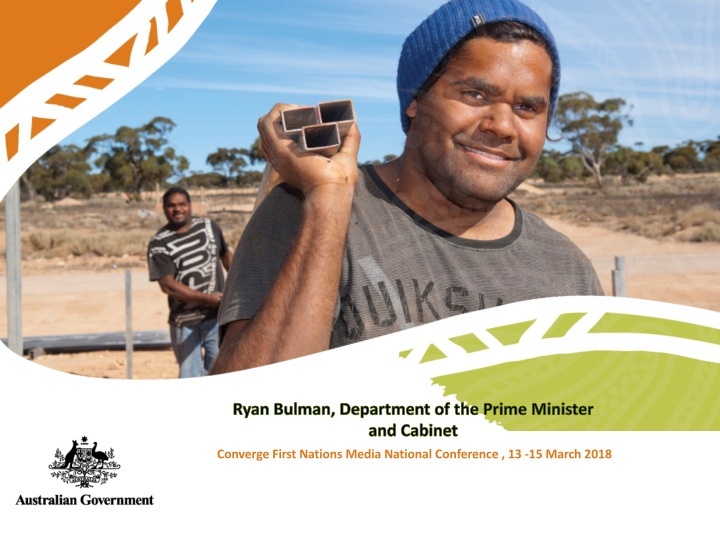



Converge First Nations Media National Conference , 13 -15 March 2018
Australian Government and Indigenous broadcasting share a long history • 1970s: sector commenced – 1987: Australian Government develops Broadcasting for Remote Aboriginal Communities Scheme – (BRACS) Current: – • 44 organisations funded to deliver 120 broadcasting services across Australia • Estimated audience reach of 100,000 regular listeners
• Funding of appx. $63m over 3 years (to 2020) • Supporting 44 Indigenous broadcasting organisations, and IRCA
Engaged Social Venture Australia to conduct an SROI study • – To demonstrate the wide range of benefits provided by the sector, beyond broadcasting – The SROI provides data to help get that message out – Part of the Government’s commitment to evaluating priority programmes and activities
PAW Umeewarra GIS (remote) (regional) (urban) • Cost benefit analysis IBS type RIMO, ICRS ICRS operating a network of • An established evaluation Remote IBS’s methodology State NT SA NSW Remoteness Very remote Regional Urban Broadcasting 450,000 km 2 150 km 2 9000 km 2 Three IBS chosen as case studies: • range – PAW (remote) Cultural Predominantly At least 30 Diverse Aboriginal groups in the Pintubi, distinct and Torres Strait – Umeewarra (regional) community Anmatjere and Aboriginal Islander language – GIS (urban) Warlpiri language groups and non- peoples. Also groups Indigenous Kaytetye, Australian cultural Case studies supported by • Gurindji, groups sector-wide consultation Eastern Arrente, Warumungu and Luritja. Estimated 6,000 15,000 213,000 audience size
$2.87 of social, cultural and economic value for every $1 • invested IBS provide much more than radio: • – community assets; contribute to strengthening culture, community development and the local economy Total input Total Present Value of three IBSs $25,791,249 (PV) Investment in three IBSs (including $8,986,984 investment of volunteer hours) Net Present Value (PV minus the $16,804,265 investment) SROI ratio $2.87 Compares favorably with other Government investments in Indigenous • programmes, e.g. average return higher than for the Indigenous Protected Areas programme
Key Insights 1. More than radio, community assets that strengthen culture, community development and local economies. 2. Outcomes are consistent but activities are varied. 3. Tailored to community needs. 4. Achieving a range of social returns for a variety of stakeholders. 5. Contribute to more of Government priorities then realised. 6. Can leverage Government funds to generate extra revenue, subject to sufficient resourcing.
• Indigenous broadcasting services are important to their stakeholders. Systematic monitoring Cooperative and response to engagement on community communication of communication needs community and 12% government priorities 17% Contribution to cultural expression and maintenance 10% Contribution to Contribution to community economic community social development development 19% 42% Importance of the Sector to stakeholders
• Opportunities: – Diversifying and innovating – Sharing lessons learned • Challenges: – Generating income – Ensuring long term sustainability – Retaining and developing Indigenous staff – Maintaining audiences in a digital world A tool to demonstrate value of the sector to stakeholders
• Quantifies the good work Measuring Value from Indigenous done by the sector Broadcasting • Demonstrates real outcomes • Combined with other research gives us a more complete picture
Recommend
More recommend